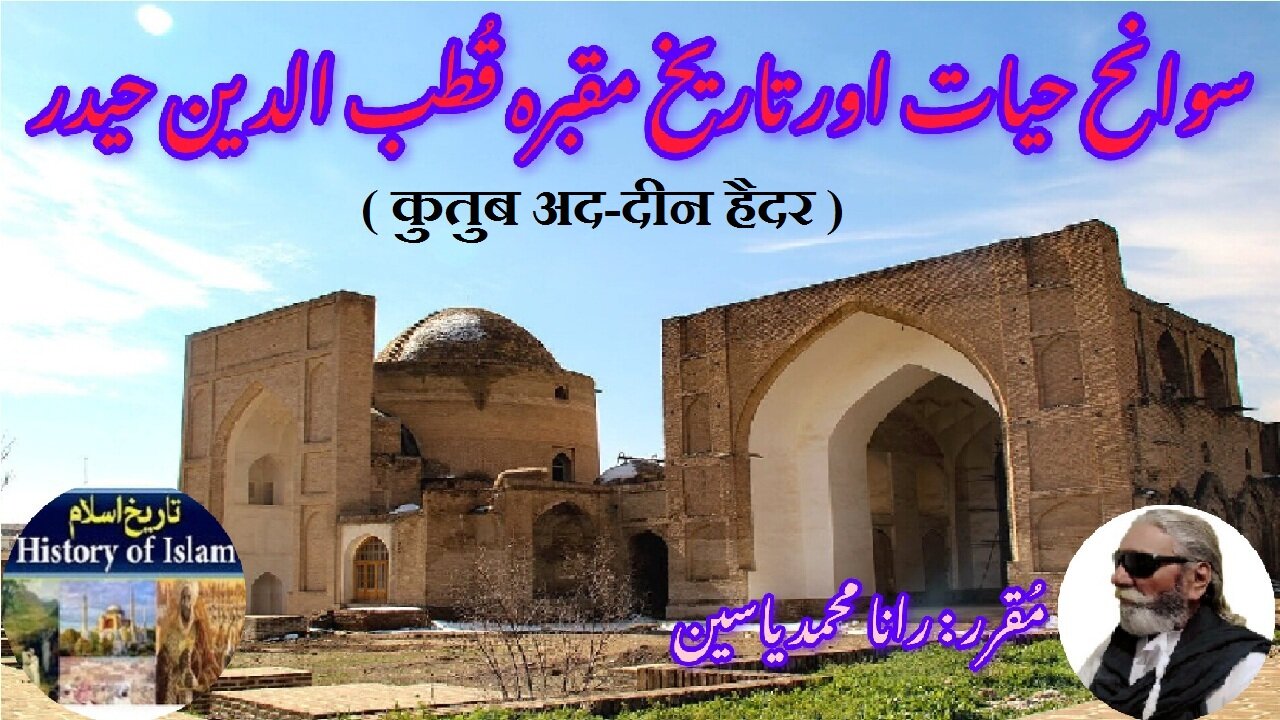Premium Only Content

Qutb ad-Din Haydar | कुतुब अद-दीन हैदर | سوانح حیات قطب الدین حیدر اور مزار کی تاریخ
@islamichistory813 #biography #qutbadin #haydar #sufisaint #culturalheritage #biography #islamicmysticism #islamic #philosophy #shrine #historical #figures
Biography of Qutb ad-Din Haydar and the history of his shrine
Dekhti Aankhooon aur sountay kaanoon ko Asslamoalaikum, sisters, brothers friends and elders, in informative series videos of Islamic ascolars, sufisaints, cultural heritages, islamic philosophys, islamic mysticisms and historical figures. today we are describing biography of Qutb ad-Din Haydar and the history of his shrine.
Qutb ad-Din Haydar, a Persian Sufi saint of possible Turkic origin, holds a significant place in the history of Islamic mysticism, particularly in the Malamati-Qalandari tradition, which emphasizes self-effacement and asceticism. His life and teachings are surrounded by mystery, and many aspects of his biography remain speculative, yet his spiritual influence, particularly in Khurasan, has endured for centuries. According to historical accounts, including the *Tarikh-i Guzida* written by Qazvini, Haydar was a contemporary of the Mongol invasions of Central Asia, specifically during the tumultuous period around 1220 CE, and it is generally believed that he passed away in 1221 CE or 618 AH. His death coincided with the height of the Mongol invasions, a moment of great upheaval for the Islamic world, and it marked the end of his personal contribution to the spread of mysticism in the region. Despite the brevity of his life, his legacy continues to resonate among Sufi practitioners, particularly through his shrine in Zava, Khurasan, which serves as a testament to his enduring influence.
Haydar's Malamati-Qalandari identity is key to understanding his spiritual journey and his place within Islamic mysticism. The Malamati-Qalandari tradition is an ascetic and often iconoclastic movement that emphasizes personal detachment from worldly recognition and approval. Its practitioners, known as Qalandars, often took unconventional paths in their devotion to God, deliberately flouting social norms and engaging in behaviors that were intended to defy the expectations of the wider society. This movement stood in stark contrast to the more institutionalized forms of Sufism, as Qalandars sought to transcend ego and attain closeness to the Divine by embracing humility and living in a state of constant self-reflection. Haydar, with his austere lifestyle, was a leading figure in this movement and is believed to have embodied the Malamati-Qalandari ideal through his asceticism, spiritual discipline, and rejection of worldly recognition.
One of the notable aspects of Haydar's life and spiritual practices is his association with the use of cannabis, which, during the time of his life, was beginning to be incorporated into the religious and mystical practices of certain Sufi circles. While the use of intoxicants such as cannabis was not universally accepted across all Islamic traditions, some Sufi groups believed that such substances could facilitate a deeper connection to the Divine by aiding in the transcendence of the ego. It is in this context that Haydar's life can be seen as significant in the history of the integration of cannabis into the mystical practices of Islam. Historical records from the time suggest that cannabis was becoming increasingly popular among Sufi mystics as a means of spiritual elevation, and Haydar’s contemporaries may have regarded its use as a tool for achieving a heightened state of awareness or mystical experience. It is important to note that while the use of intoxicants has been widely condemned in mainstream Islamic law, within certain Sufi traditions, it was seen as a means of breaking through the barriers of the self and connecting with the Divine.
Haydar's life and teachings are also closely linked to the broader historical context of the Mongol invasions. The 13th century, during which Haydar lived, was a time of immense disruption for the Islamic world. The Mongol invasions led to the fall of many prominent cities in Central Asia, including the great centers of Persian and Khurasani culture, which had been hubs of intellectual and spiritual activity. As the Mongols ravaged the region, many Sufi orders and mystics were forced to adapt to new political and social realities. Haydar’s death in 1221 coincided with the height of this devastation, and his passing marked the end of a particular era of Sufi spirituality in Khurasan. Nevertheless, his teachings and practices continued to influence those who sought refuge in the mystical traditions of Islam, even as the world around them was being reshaped by the Mongol onslaught.
Qutb ad-Din Haydar’s shrine in Zava, Khurasan, stands as a significant site of pilgrimage and spiritual reflection. Despite the passage of time and the changing political landscapes of the region, Haydar's shrine has remained a focal point for those seeking to connect with his spiritual legacy. Pilgrims visit the shrine not only to honor Haydar’s memory but also to seek solace and guidance in their own spiritual journeys. The shrine represents the continuity of Sufi traditions in the face of external challenges, serving as a reminder of the resilience of spiritual practices in times of adversity. The site has become a place where the teachings of Haydar can still be felt, and where individuals come to reflect on the asceticism, humility, and self-effacement that characterized his life.
Furthermore, Haydar's shrine in Zava is significant for its role in preserving the history of the Malamati-Qalandari tradition, as well as the broader history of Sufism in Khurasan. The region itself has long been a center of Sufi activity, and many important Sufi saints and scholars have been associated with it. Haydar’s contributions to the development of Sufism in Khurasan, particularly his embodiment of the Qalandari ideal, have left a lasting imprint on the spiritual landscape of the area. His teachings continue to inspire contemporary Sufi practitioners who seek to follow the path of asceticism, humility, and spiritual enlightenment.
In conclusion, Qutb ad-Din Haydar was a key figure in the development of early Islamic mysticism, particularly in the Malamati-Qalandari tradition. His life, which spanned a period of great upheaval in the Islamic world, reflects the resilience of Sufi spirituality in the face of external challenges. His association with the use of cannabis as a tool for spiritual enlightenment, along with his emphasis on asceticism and self-effacement, highlights the diversity of mystical practices within Islam. Haydar's death during the Mongol invasions did not mark the end of his influence; rather, his shrine in Zava continues to serve as a site of pilgrimage and spiritual reflection. His legacy endures, not only in the history of Sufism but also in the enduring importance of his teachings, which continue to inspire those seeking a deeper connection with the Divine.
With this, we seek your permission until tomorrow, tomorrow we will describe the biography of Qutb al-Din al-Shiraziand the history of his Shrine.
========================
-
 29:41
29:41
ISLAMIC HISTORY
2 hours agoHazrat Safiyyah (RA) | The brave women protector of Medina | حضرت صفیہؓ مدینہ کی بہادر خاتون محافظ
4 -
 LIVE
LIVE
Akademiks
1 hour agoWar in RAT-LANTA. Young Thug vs Gunna vs Ralo vs YSL MONDO. Who Will Le Bebe Pick. FINAL CRASHOUT!
6,002 watching -
 UPCOMING
UPCOMING
Jeff Ahern
21 minutes agoThe Saturday show with Jeff Ahern
1 -
 LIVE
LIVE
DynastyXL
7 hours ago🔴LIVE: Fortnite The Comeback Stream Starts Here🎃
89 watching -
 LIVE
LIVE
BrightGaming
1 hour agoDragon Warrior 1 (NES): Defeat the DragonLord & Save the Kingdom as Erdrick's Heir with BrightGaming
1,037 watching -
 19:15
19:15
Stephen Gardner
18 hours ago🟢YES! Trump did it! + Elon Musk DROPS BOMBSHELL on Democrat Party!
110K210 -
 29:24
29:24
Afshin Rattansi's Going Underground
1 day agoEx-CIA Advisor & Afshin Rattansi Have HEATED Exchange Over Ukraine Proxy War
3.21K32 -
 1:06:17
1:06:17
Mike Rowe
20 hours agoThe Mastermind Behind THIS Radical Idea At WSU Tech | Sheree Utash #448 | The Way I Heard It
93.6K17 -
 1:29:13
1:29:13
I_Came_With_Fire_Podcast
13 hours agoAncient Egypt's Tech & the Secret Temples of Malta
17.2K2 -
 LIVE
LIVE
GritsGG
3 hours agoWin Streaking! Most Wins 3499+ 🧠
124 watching